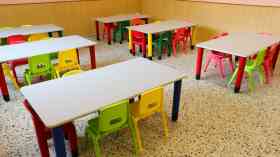Getting the basics right
 Schools, like everyone else, face increased bills as global demand for energy continues to grow. The money has to come from somewhere which can put the squeeze on maintenance or capital budgets. Yet there are ways of examining usage and identifying ways of reducing expenditure.
Schools, like everyone else, face increased bills as global demand for energy continues to grow. The money has to come from somewhere which can put the squeeze on maintenance or capital budgets. Yet there are ways of examining usage and identifying ways of reducing expenditure.
Energy sometimes seems to be an uncontrollable overhead: we need heating, lighting, power for equipment, etc. It can be difficult to know where to begin. Well, the first stop should be the bill.
The bill should give you monthly breakdowns of expenditure and, in the absence of anything else, year-on-year consumption can be compared, i.e. the number of kWh of electricity or gas. Clearly, the figures need to be compared with the same time last year in order to see whether there are any significant unexplained increases (or decreases) in consumption. The reason is that comparing this September’s figure with last June’s will not give a meaningful comparison – consumption patterns are quite different between early autumn and early summer (even given the summer we have just had!).
Another immediate source of information is the Display Energy Certificate (DEC) that all publicly-funded schools are required to produce each year. DECs are a snapshot of energy performance and should be at least broadly similar from year to year. By comparing this with previous years’ ratings it will become obvious whether energy performance is improving or not. In addition, DECs give an indication (although only a general one) of how well the school is doing compared to the ‘average’. Now school buildings do not tend to be ‘system built’, they tend to vary in age, layout, fabric, etc, but the DECs can at least give a general idea of energy efficiency levels.
Monitoring & Targeting
The meters can be used to track consumption. That will give you information about how much energy is being used and also the pattern. Regular data-collecting and analysis will enable the patterns of consumption to be identified. This can then serve as a basis for action. This process is generally known as ‘Monitoring & Targeting’: find out the pattern of consumption, identify where it is excessive or anomalous and then take action to rectify the situation.
M&T systems range from small spreadsheet-based options with manual data collection and input, right through to automatic M&T where the data collection is handled remotely and sophisticated analysis is carried out in order to identify a range of options and reports. aM&T is having an effect on energy management similar to the automation of office administration systems back in the 1990s. They eliminate the tedious, repetitive tasks and free users to take action. Their effectiveness has been recognised by the Government who are incorporating them into the Building Regulations and the CRC Energy Efficiency Scheme – in which all publicly-funded schools have been included. Many of the newer aM&T systems are also approved to produce the annual DECs required by European (and UK) legislation.
The consumption patterns can give an indication where immediate savings can be made. For instance, if consumption does not dip significantly once the school closes, then that might indicate equipment being left on unnecessarily. If the water meter indicates consumption during the night, that may indicate a leak somewhere or that, perhaps, the toilets are still on a standard flushing cycle 24 hours a day. Excessive heating may be caused by a stuck switch or thermostat on the boiler.
Around March and October, there are often spikes in energy consumption caused by timeclocks not resetting themselves properly at the change between GMT and BST.
In addition, most equipment will eventually drift from its original control settings even and this can lead to loss of performance. Meter data can help identify this drift and check that corrective measures have indeed been effective.
This highlights the importance of controls. Energy efficient equipment will still waste energy if used unnecessarily. Lighting that is on overnight or constantly illuminating storerooms still costs the school money which could be put to better use.
In fact, lighting is one area where significant savings can be achieved. Most schools are aware of the value of replacing conventional lighting with low energy versions. However, there are also a range of control systems available – from simple timeswitches that ensure all the lighting goes off (apart from security lighting) after a certain time, through zoning controls, to occupancy sensing and daylight sensors. Different levels of lighting may also be appropriate for different areas – a lower level for corridors and storage areas but higher levels for classrooms and other places where pupils are reading or writing.
Renewable energy
Many schools are looking at the feasibility of on-site renewable energy systems as a way to cut their emissions. There are grants available for some of these options as well. However, it is important to work out the relative merits of different projects. The Government’s programme to promote micro-generation technologies via Feed In Tariffs (FITs) is based on a 8% return on investment (ROI). The new Renewable Heat Incentive (RHI), based on 12% ROI, has prompted wide interest and some investment. However, most energy efficiency technologies have a payback time just a fraction of those for on-site renewables, in some cases only a few months, giving an ROI often well over 30%.
This is not to suggest that energy efficiency and renewables are mutually exclusive. They can both play an important part in cutting emissions. Indeed, by reducing the overall consumption, energy efficiency measures can make investment in renewable technologies more viable and lead to shorter payback times.
The educational aspects
Environmental protection, climate change and sustainability all feature in school syllabuses today. Energy management can be a practical way of exploring these subjects. Reducing energy use can cut emissions and improve resource efficiency. Many meters and energy management systems today can be accessed through PCs and this enables the subject to be brought into the classroom.
Educating students to be mindful of energy and alert for opportunities to save energy can have multiple benefits. It helps the school to reduce its bills while engaging the whole student body in actively seeking ways to aid that process. It promotes environmental awareness amongst the students and teaches them strategies to avoid waste. And it may even improve energy efficiency in the home as students take their learning home.
Attention to energy efficiency can benefit both the school and the wider community.
The Energy Services and Technology Association (ESTA) represents over 100 major providers of energy management equipment and services across the UK.
For more details visit the website at www.esta.org.uk
Latest News
19/12/2025 - 09:54
The Education Committee has expanded its ongoing inquiry into the early years sector to examine how safeguarding can be strengthened in early years settings.
18/12/2025 - 09:25
The UK will be rejoining the Erasmus programme in 2027, following a package of agreements with the EU.
17/12/2025 - 09:31
Ofqual has fined exam board Pearson more than £2 million in total for serious breaches in three separate cases between 2019 and 2023 which collectively affected tens of thousands of students.
16/12/2025 - 09:19
The average funding rates will increase by 4.3% for under 2s, and by almost 5% for 3-and-4-year-olds.
15/12/2025 - 10:30
Local colleges are set to receive £570 million in government funding to expand training facilities in areas such as construction and engineering.







